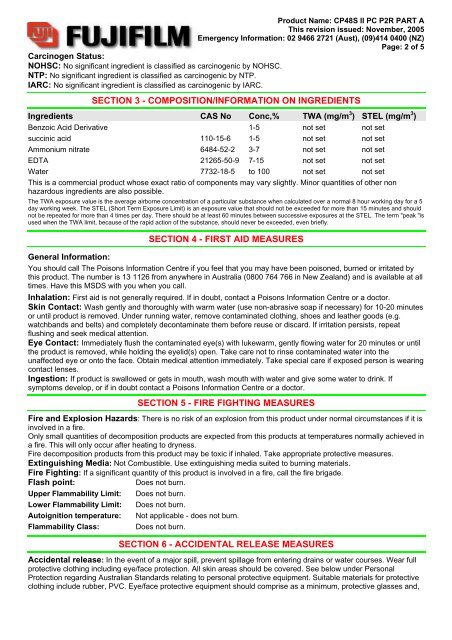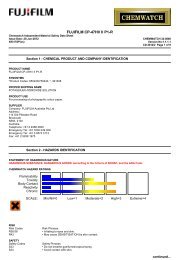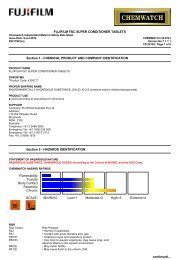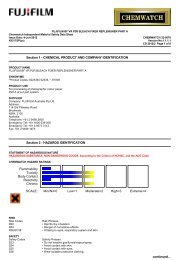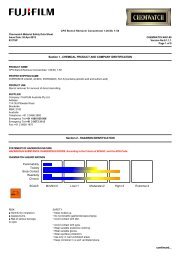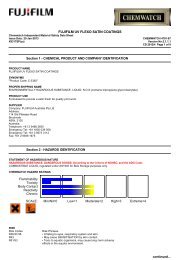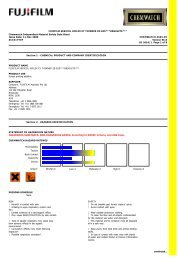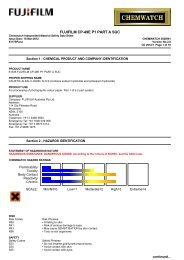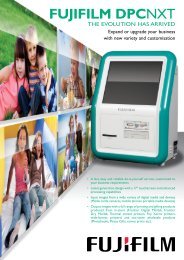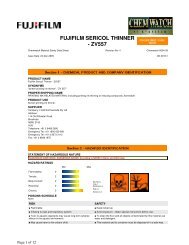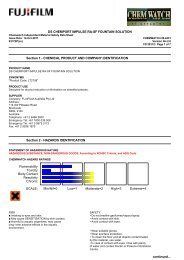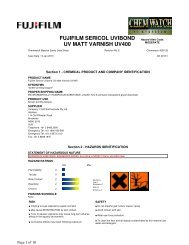CP48S II PC P2R PART A - FUJIFILM Australia
CP48S II PC P2R PART A - FUJIFILM Australia
CP48S II PC P2R PART A - FUJIFILM Australia
Create successful ePaper yourself
Turn your PDF publications into a flip-book with our unique Google optimized e-Paper software.
Product Name: <strong>CP48S</strong> <strong>II</strong> <strong>PC</strong> <strong>P2R</strong> <strong>PART</strong> AThis revision issued: November, 2005Emergency Information: 02 9466 2721 (Aust), (09)414 0400 (NZ)Page: 2 of 5Carcinogen Status:NOHSC: No significant ingredient is classified as carcinogenic by NOHSC.NTP: No significant ingredient is classified as carcinogenic by NTP.IARC: No significant ingredient is classified as carcinogenic by IARC.SECTION 3 - COMPOSITION/INFORMATION ON INGREDIENTSIngredients CAS No Conc,% TWA (mg/m 3 ) STEL (mg/m 3 )Benzoic Acid Derivative 1-5 not set not setsuccinic acid 110-15-6 1-5 not set not setAmmonium nitrate 6484-52-2 3-7 not set not setEDTA 21265-50-9 7-15 not set not setWater 7732-18-5 to 100 not set not setThis is a commercial product whose exact ratio of components may vary slightly. Minor quantities of other nonhazardous ingredients are also possible.The TWA exposure value is the average airborne concentration of a particular substance when calculated over a normal 8 hour working day for a 5day working week. The STEL (Short Term Exposure Limit) is an exposure value that should not be exceeded for more than 15 minutes and shouldnot be repeated for more than 4 times per day. There should be at least 60 minutes between successive exposures at the STEL. The term "peak "isused when the TWA limit, because of the rapid action of the substance, should never be exceeded, even briefly.SECTION 4 - FIRST AID MEASURESGeneral Information:You should call The Poisons Information Centre if you feel that you may have been poisoned, burned or irritated bythis product. The number is 13 1126 from anywhere in <strong>Australia</strong> (0800 764 766 in New Zealand) and is available at alltimes. Have this MSDS with you when you call.Inhalation: First aid is not generally required. If in doubt, contact a Poisons Information Centre or a doctor.Skin Contact: Wash gently and thoroughly with warm water (use non-abrasive soap if necessary) for 10-20 minutesor until product is removed. Under running water, remove contaminated clothing, shoes and leather goods (e.g.watchbands and belts) and completely decontaminate them before reuse or discard. If irritation persists, repeatflushing and seek medical attention.Eye Contact: Immediately flush the contaminated eye(s) with lukewarm, gently flowing water for 20 minutes or untilthe product is removed, while holding the eyelid(s) open. Take care not to rinse contaminated water into theunaffected eye or onto the face. Obtain medical attention immediately. Take special care if exposed person is wearingcontact lenses.Ingestion: If product is swallowed or gets in mouth, wash mouth with water and give some water to drink. Ifsymptoms develop, or if in doubt contact a Poisons Information Centre or a doctor.SECTION 5 - FIRE FIGHTING MEASURESFire and Explosion Hazards: There is no risk of an explosion from this product under normal circumstances if it isinvolved in a fire.Only small quantities of decomposition products are expected from this products at temperatures normally achieved ina fire. This will only occur after heating to dryness.Fire decomposition products from this product may be toxic if inhaled. Take appropriate protective measures.Extinguishing Media: Not Combustible. Use extinguishing media suited to burning materials.Fire Fighting: If a significant quantity of this product is involved in a fire, call the fire brigade.Flash point:Does not burn.Upper Flammability Limit: Does not burn.Lower Flammability Limit: Does not burn.Autoignition temperature: Not applicable - does not burn.Flammability Class: Does not burn.SECTION 6 - ACCIDENTAL RELEASE MEASURESAccidental release: In the event of a major spill, prevent spillage from entering drains or water courses. Wear fullprotective clothing including eye/face protection. All skin areas should be covered. See below under PersonalProtection regarding <strong>Australia</strong>n Standards relating to personal protective equipment. Suitable materials for protectiveclothing include rubber, PVC. Eye/face protective equipment should comprise as a minimum, protective glasses and,


